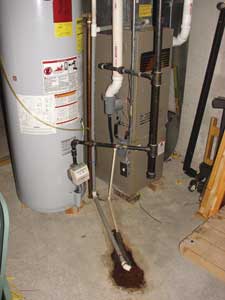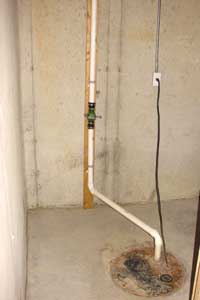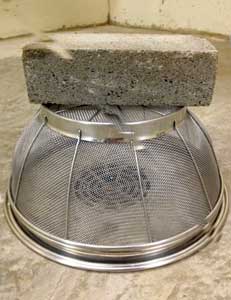By DAVE JETTER
Firefighters learn to improvise to solve problems and assist those who call them for help. Several years ago, during a destructive storm, my fire department responded to nearly 250 calls that night; approximately 60 percent of those incidents were for basement flooding. One of those incidents found a coworker and I using a common kitchen utensil to solve a water problem.
In my community, many houses have basements or crawl spaces. The homes with basements usually have a floor drain where water can be drained. Sump pumps are also commonly used to remove water from a pit that is along an exterior wall (photos 1, 2). These pits collect water from pipes that are along the footer of basement walls. The water enters the pipes and is directed to the sump pump pit. Once the float switch on the pump engages, it discharges the water into a drain or pumps it outside the building. This process prevents water from entering the basement of a home. Many of these pumps operate electrically; in the case of severe power outages, fire departments should expect flooded basements.
 |
| (1) In this home, a drain is within a few feet of the furnace. This drain removes water discharge from central air-conditioning units; a humidifier, if present; and condensate from condensing furnaces. If water accumulates in the basement because of flooding, eventually the water will enter the drain and be removed to the home’s exterior by gravity. (Photos by author.) |
 |
| (2) This sump pump pit is on an exterior wall in a home’s basement. Notice the pipe that extends up the wall to the left of the pit as well as the electric cord, which is essential to the pump’s effectiveness. When in operation, the pump discharges water from the pit and up through the pipe to the home’s exterior. During electrical outages, the pump cannot operate since it has no power source. |
Most of the basement flooding calls to which my crew and I responded had only a few inches of water, which was usually shallow enough to allow us to investigate the problem with a flashlight. If the depth of the water was such that it covered the top of our bunker boots, we did not enter the basement because we considered it unsafe; we could not clearly see into the water to identify trip hazards, open pits, contaminants, or the exact location of drains. We also had concerns about the proximity of the water level to electrical outlets, and we did not want the water to fill our boots and come in contact with our skin.
After the first few responses, we found an accumulation of small items such as toys, dust, lint, and other objects around the drains that were preventing water from leaving the basement (photo 3). These small items were easily moved by the water, which eventually caused them to gather and create a clog. The minimal surface area of the drain makes it susceptible to clogging. Most of my community was without power during this storm, so those homes relying on electricity to power a sump pump were at the will of Mother Nature. Because gravity drainage was not available, there was nothing the fire department could do; we did not have enough generators to lend to all those who needed one.
 |
| (3) Because the surface area of the drain is minimal, small items such as toys and lint can cause a clog. These types of items are easily moved by water and are often found covering drains during flooding. |
When we found an accumulation of small items, we wiped them away so the water would drain. However, it was apparent we needed to find a solution to prevent the drain from clogging again. After some discussion, we decided to try a kitchen colander or strainer (photo 4). Once we got it from the homeowner, we placed the colander/strainer over the floor drain and sat something atop to keep it from moving as the water flowed toward the drain (photo 5). To our satisfaction, this simple tool was very effective. After the first house, we used the method for many other water emergencies and found it worked consistently. This method allowed most, but not all, of the water to drain and helped prevent further accumulation of water.
 |
| (4) Often, homeowners have either a colander or strainer-or sometimes both-available. If given a choice, a strainer is optimal because of the larger surface area it offers for drainage. Colanders have fewer holes and are more restrictive to water movement than strainers, although they still work. |
 |
| (5) Once the drain is cleared, place either the strainer or colander over the drain, and find something heavy to hold it in place. Sometimes, you may find piping from a furnace right next to or on top of a drain (photo 1). In those cases, move the pipe to the side of the drain, leaving enough room for the strainer/colander to fit over it. Always use caution; some furnaces, pumps, or water heaters may have overflow pipes permanently attached, and they will snap or break if moved. If you set the strainer/colander on top of the piping, the large gap beneath it will allow the small items to reaccumulate and possibly cause another clog. |
The next time you respond to a flooded basement that uses gravity for drainage, give this simple method a try. There are few people who do not have a colander or strainer in their home. At first, you may get a raised eyebrow, but after the distressed homeowner sees the result, he will be pleased with your resourcefulness.
My crew and I learned some valuable lessons from this experience, which included the following:
- Basements may be finished or unfinished. Either way, the height of an electrical outlet is a concern; they may be 18 inches or 48 inches from the floor. Often, finished basements have electrical outlets closer to the floor. Also, there is no guarantee that the outlets are the ground fault circuit interrupter type. If the home is without power, there is still a concern that power may be restored. If the water level affects the electrical or gas utilities, call the utility company.
- If needed, move furniture and objects to create a pathway for the water to flow to the drain, and stack the furniture above the water line if possible. Also, open closed doors for best results. If time permits, as an excellent display of customer service, assist the homeowner with stacking items above the water line.
- The only part of our personal protective equipment that we wore when investigating a basement were our bunker boots. We did not consider our bunker pants necessary, and we saw no reason to contaminate them in the water and whatever contaminants may have been present. As a result, there was no issue with decontaminating our turnout gear post-response. If responding personnel have access to hip boots, wader boots, or old three-quarter boots, wear them for more protection and to provide for better access into basements or for other water operations.
- Always proceed with caution when investigating a flooded basement; a person’s basement is also a place for storage. The hazards that can be found in a basement are limitless; they can include sewage, heating oil from a tank used to supply a furnace, and a wide assortment of chemicals and petroleum products.
DAVE JETTER is a 20-year fire service veteran and a lieutenant and fire instructor with the Miami Township (OH) Fire and EMS. He teaches at Wayne Township Fire Training Academy and has a bachelor’s degree from the University of Cincinnati.
Fire Engineering Archives

